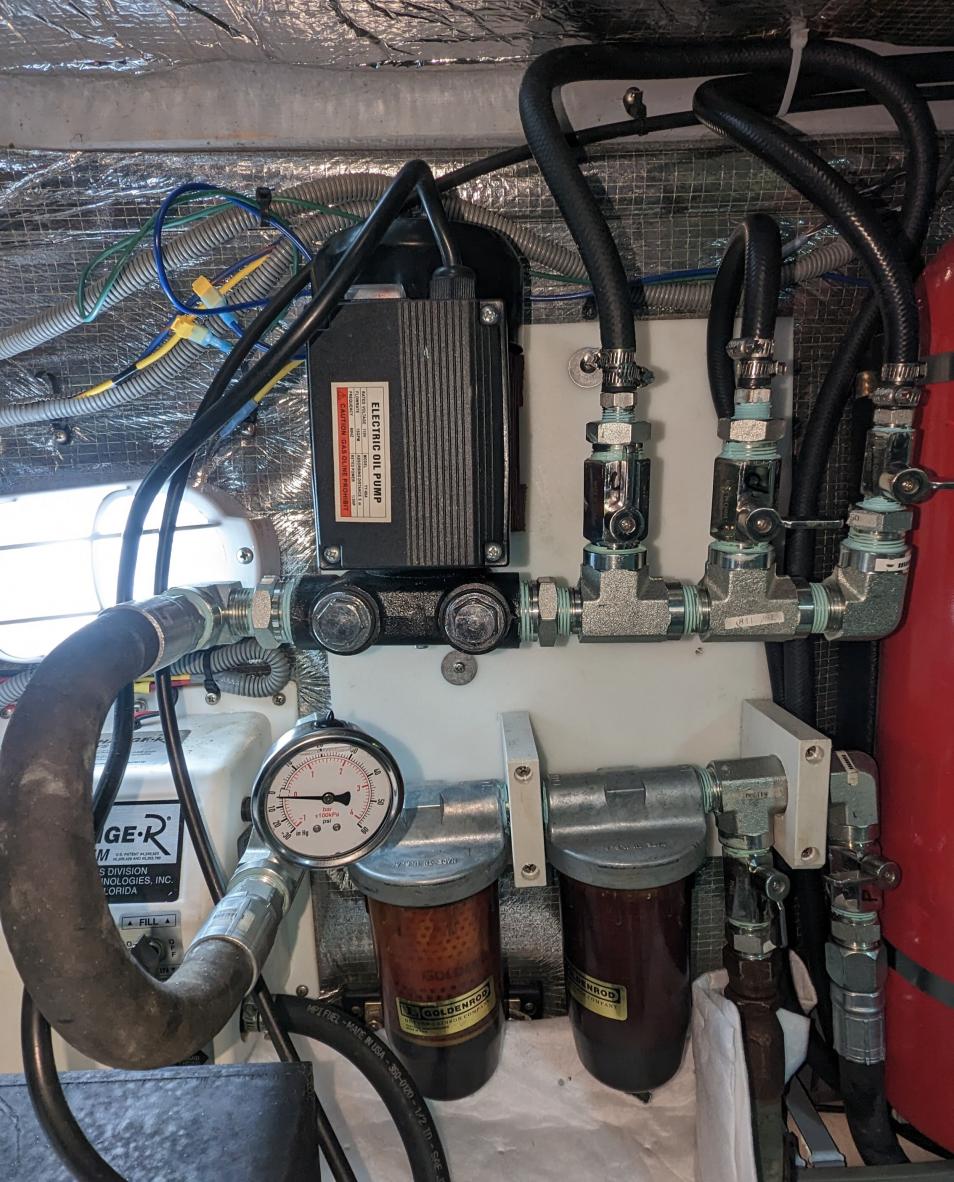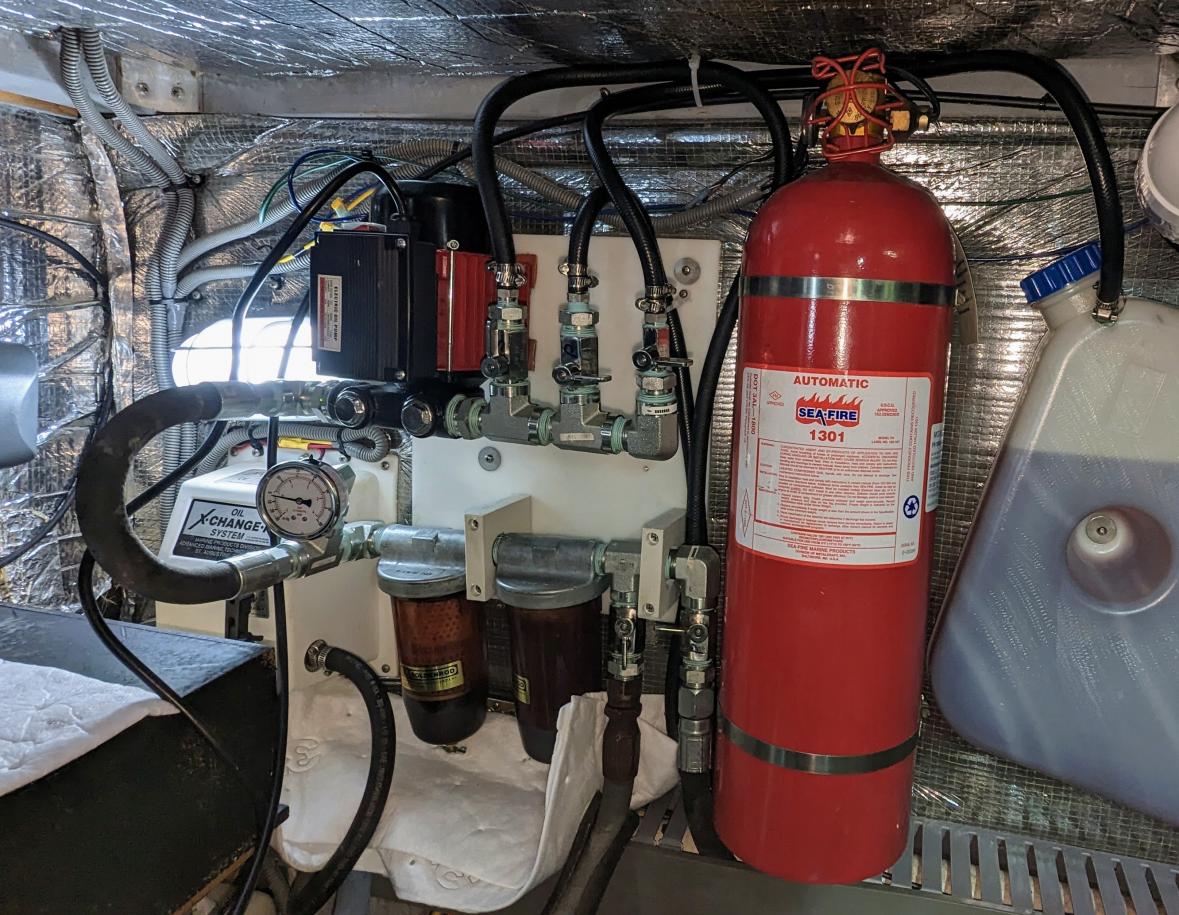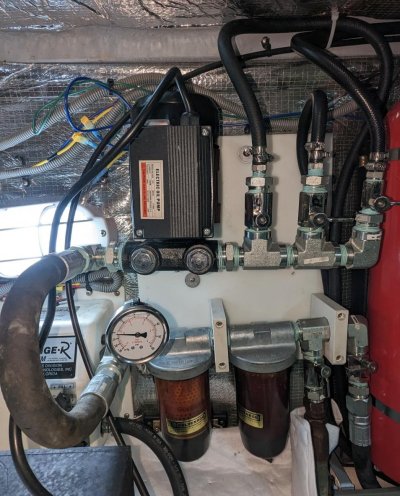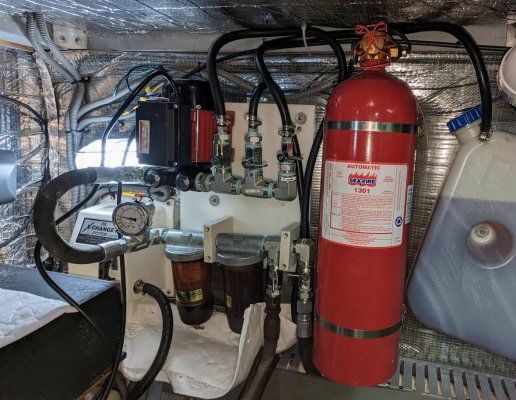Waterant
Senior Member
Hey guys,
I want to share my DIY fuel polishing system because everything I found on youtube, and forums and being sold out there is way too slow for 400-gallon tanks and would take hours to do one fuel rotation.
My system does 15 Gal per min (measured with a 15 Gal bucket).
so each 200G tank takes only 14 minutes to rotate once (with clean filters).

Two filters. For the first rotation, I used 80 Micron mesh in the first filter and 17-micron water-absorbing fuel filter element for the second filter just to filter out the bigger crap from the tanks on the first run.
A permanent setup will be 17-micron water separator first and 10 micron filter second.

One 3/4" ID hose comes from the bottom of the port tank, and another is from the bottom of the starboard tank.
One 3/8" ID hose is going to the opposite side of the port tank return line
another 3/8" ID hose is going to the opposite side of the starboard tank return line - this helps to steer up the fuel in the tank
The third 3/8" hose is going to the diesel heater day tank.
This system can polish the fuel and transfer it from one tank to another to balance them and put the filtered fuel into the day tank of the heater.
I did not invent it - a similar setup is used on the farms to pump fuel from the big tanks into the farm equipment.
It's compact and super fast. The only problem is because of the metal impeller in the pump, it is very noisy. The good news, it takes minutes to rotate a tank once so you do not have to hear it for long.
Components:
1x Self-priming Oil Transfer Pump with metal impeller (110V AC, 15GPM)
1x Goldenrod Fuel Filter Assembly with 10 Micron Fuel Filter (17 micron, 25 GPM max flow rate)
1x Goldenrod Fuel Filter Assembly with 17 Micron Water-Absorbing Fuel Filter (10-micron, 25 GPM max flow rate)
1x Goldenrod (470-5) Replacement Fuel Filter Element (17-micron)
1x GOLDENROD (496-5) Fuel Tank Filter Replacement Water-Block Element (10-micron)
1x Vacuum / Pressure Gauge -30~60Psi Stainless 1/4" NPT 2.5"
2x 3/4 inch Stainless Mini Ball Valve
3x 3/8 inch Stainless Mini Ball Valve
Gasoila - SS04 Soft-Set Pipe Thread Sealant with PTFE
Backplate and holder blocks are made from starboard or any HDPE plastic 1/2 or 3/4 will work
Steel fittings 1" and 3/4" for hydraulic lines were purchased locally.
The total cost is ~$300
I already ran it for 30 minutes on each tank (both are half full) and did not notice any issues. If you see any problems with it, comments and suggestions are always welcome.
I want to share my DIY fuel polishing system because everything I found on youtube, and forums and being sold out there is way too slow for 400-gallon tanks and would take hours to do one fuel rotation.
My system does 15 Gal per min (measured with a 15 Gal bucket).
so each 200G tank takes only 14 minutes to rotate once (with clean filters).
Two filters. For the first rotation, I used 80 Micron mesh in the first filter and 17-micron water-absorbing fuel filter element for the second filter just to filter out the bigger crap from the tanks on the first run.
A permanent setup will be 17-micron water separator first and 10 micron filter second.
One 3/4" ID hose comes from the bottom of the port tank, and another is from the bottom of the starboard tank.
One 3/8" ID hose is going to the opposite side of the port tank return line
another 3/8" ID hose is going to the opposite side of the starboard tank return line - this helps to steer up the fuel in the tank
The third 3/8" hose is going to the diesel heater day tank.
This system can polish the fuel and transfer it from one tank to another to balance them and put the filtered fuel into the day tank of the heater.
I did not invent it - a similar setup is used on the farms to pump fuel from the big tanks into the farm equipment.
It's compact and super fast. The only problem is because of the metal impeller in the pump, it is very noisy. The good news, it takes minutes to rotate a tank once so you do not have to hear it for long.
Components:
1x Self-priming Oil Transfer Pump with metal impeller (110V AC, 15GPM)
1x Goldenrod Fuel Filter Assembly with 10 Micron Fuel Filter (17 micron, 25 GPM max flow rate)
1x Goldenrod Fuel Filter Assembly with 17 Micron Water-Absorbing Fuel Filter (10-micron, 25 GPM max flow rate)
1x Goldenrod (470-5) Replacement Fuel Filter Element (17-micron)
1x GOLDENROD (496-5) Fuel Tank Filter Replacement Water-Block Element (10-micron)
1x Vacuum / Pressure Gauge -30~60Psi Stainless 1/4" NPT 2.5"
2x 3/4 inch Stainless Mini Ball Valve
3x 3/8 inch Stainless Mini Ball Valve
Gasoila - SS04 Soft-Set Pipe Thread Sealant with PTFE
Backplate and holder blocks are made from starboard or any HDPE plastic 1/2 or 3/4 will work
Steel fittings 1" and 3/4" for hydraulic lines were purchased locally.
The total cost is ~$300
I already ran it for 30 minutes on each tank (both are half full) and did not notice any issues. If you see any problems with it, comments and suggestions are always welcome.
Attachments
Last edited:



 One of them is used by the generator return line and I installed a T connection. From what I could find, this will not affect the generator in any way and return line sharing is done by many boat manufacturers. I'll try not to run the polishing and generator simultaneously just in case. which means polishing while on the shore power or via the inverter. Another plus of a fast 110v system is that I do not need to run it for many hours on the inverter.
One of them is used by the generator return line and I installed a T connection. From what I could find, this will not affect the generator in any way and return line sharing is done by many boat manufacturers. I'll try not to run the polishing and generator simultaneously just in case. which means polishing while on the shore power or via the inverter. Another plus of a fast 110v system is that I do not need to run it for many hours on the inverter. I'm in this situation now with both tanks half full of questionable fuel inherited from the previous owner. I'll do this "between tanks" transfer the next time.
I'm in this situation now with both tanks half full of questionable fuel inherited from the previous owner. I'll do this "between tanks" transfer the next time. .
.